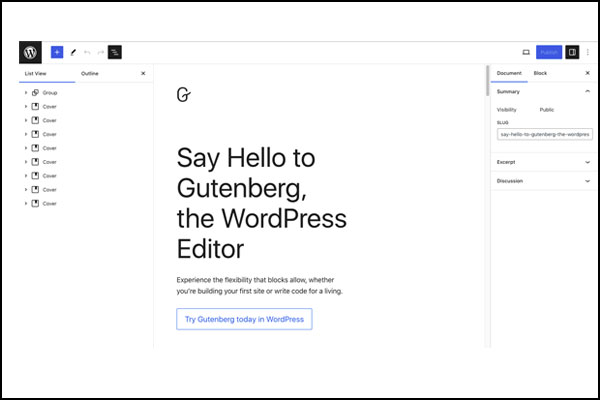For the last couple of years WordPress has been transitioning to a new theme environment referred to as Gutenberg, Full Site Editing (FSE for short), and/or Blocks. The original name for the framework was Gutenberg; they later changed it to Full Site Editing and the framework is based on using “blocks”. So you may see or hear all four labels that ultimately refer to the same thing!
The objectives of the new framework included building in the kinds of page-builder functionalities available in page-building plugins like Elementor; enabling the creation or alteration of theme elements and templates within the Editor; and reducing the use of PHP in themes.
WordPress worked incrementally, making elements of the new framework available in a series of updates, both to give designers and developers time to learn AND to get feedback from them. Throughout this period Classic PHP themes continued to work and will continue for some undetermined time to come.
WordPress has always been a mixture of user-friendliness and complexity. The complexity arises from the fact that blogs and websites are complicated beasts and every effort to simplify the building of them has advantages and drawbacks. Websites are the products of programming, using multiple languages. Most people needing and creating websites are not programmers and don’t want to be. To make it possible for the non-programmer to create a website, different programs and frameworks have been built ranging from the wide-open to the very rigid. Rigid website building programs and frameworks force templates and schemas on people with limited to no ability to modify them. Wide-open frameworks allow for near-total customization but the price is high-learning curves and complexity. WordPress is on the open end of the continuum, but with easy-but-rigid options available.
Over the years, in an effort to make sophisticated page-layout capabilities available to non-programmers, page-building plugins were created such as Elementor. These offered “drag and drop” options and other ways to visually lay out and style page and post content without having to know or apply CSS. Many theme builders incorporated Elementor and/or other page-builders (WP Bakery and others) into their themes, which had it’s positives and negatives. Page-builders have their own learning curves! WordPress also relied on plugins to enable all sorts of functionalities and effects, again with positives and negatives. Every plugin has it’s own learning curve! Plus plugins sometimes clash with other plugins, themes or page-builders causing errors or breakdowns.
The combinations of themes (which could be customized to varying degrees in the Customizer), page-builders and plugins often resulted in bloated sites that could be confusing to update and difficult to troubleshoot.
Enter Gutenberg / Full Site Editing
Gutenberg (now Full Site Editing) attempts to dramatically reduce bloat and complexity by building a visual page-builder into the Editor. Of course it has a learning curve too, but once mastered it enables sophisticated and creative layouts on posts, pages and theme templates. Effects can be extended and increased through use of block collections now available as plugins. I particularly like the Greenshift plugin which includes animated effects. FSE includes native blocks for social media and other embeds, as well as video, audio players. Various block collections include tabs, accordions, sliders and carousels, all of which used to require separate plugins. Also, there’s no more widgets; features and functionalities that used to be handled in widgets are now available as blocks, which can be placed directly in pages or posts as well as in templates and template parts (headers and footers).
When Should You Switch?
For now your Classic site should continue to chug along. Ideally your theme will be upgraded to be block-compatible. If it is you can start using blocks in pages or posts if you want to. However, if you want to remain in the Classic environment you’ll need to add Classic Editor and Classic Widgets plugins to your site. When they’re activated your Editor will look like it always has. Deactivate them and your Editor will display the new Blocks interface.
Websites need periodic updates, typically sometime between four and eight years. Going forward, when your next update is on-deck you should transition and gain the benefits. For some there may be reasons for a hybrid-transition: using a block-compatible Classic PHP theme while using blocks to lay out page and post content. This would make sense primarily for sites using custom plugins that perform critical site functions that aren’t easily replaceable. But as time passes, plugins will themselves transition to be block compatible or they’ll be abandoned.
If you’re wondering if now is the time to transition, give us a call! 330-400-4063,


